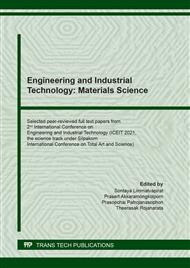p.117
p.123
p.129
p.135
p.141
p.149
p.155
p.163
p.169
Synthesis of Benzhydrol Derivatives as Antituberculosis Agents via Fries Rearrangement Method Investigated by DSC Analysis
Abstract:
Benzhydrol derivatives 2a-c were synthesized, and evaluated for antituberculosis activities. These compounds were prepared from corresponding phenyl benzoates through Fries rearrangement and reduction reaction. Fries rearrangement reaction was chosen to use due to its convenient non-solvent method for synthesis. In order to determine the effective temperature for Fries rearrangement reaction, the reaction mixtures of phenyl benzoates 4a-c and AlCl3 heated at constant rates were studied using DSC analysis. DSC curves of those mixtures showed that the reactions started at endothermic temperature ranging from 130 to 140 °C. The optimum temperatures for the synthesis of Fries rearrangement products 5a-c with high %yields were observed at 130, 140, and 130 °C, respectively. The DSC data were effectively applied for the estimation of the optimal reaction temperatures to attain high %yields for the synthesis of benzhydrols. The final benzhydrol derivatives 2a-c were structurally elucidated by FT-IR, 1H NMR, and LC-MS and evaluated for antituberculosis activities by agar-dilution method. It was found that 4-hydroxy-α-(4ʹ-fluorophenyl) benzyl alcohol 2a possessed the highest activity in the series with the minimum inhibitory concentration (MIC) of 40 µg/mL.
Info:
Periodical:
Pages:
141-146
Citation:
Online since:
March 2022
Keywords:
Price:
Сopyright:
© 2022 Trans Tech Publications Ltd. All Rights Reserved
Share:
Citation:


